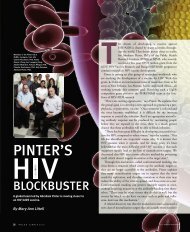changing the course of stroke - New Jersey Medical School ...
changing the course of stroke - New Jersey Medical School ...
changing the course of stroke - New Jersey Medical School ...
Create successful ePaper yourself
Turn your PDF publications into a flip-book with our unique Google optimized e-Paper software.
BATeam members work staggered shifts to cover <strong>the</strong>ir unit<br />
around <strong>the</strong> clock. Minutes after a page by EMS, o<strong>the</strong>r mimicking<br />
conditions are ruled out, and <strong>the</strong> type <strong>of</strong> <strong>stroke</strong> is determined,<br />
“We are ready to go,” explains Michael Lee, angio and<br />
X-ray technologist. In <strong>the</strong> case <strong>of</strong> an acute ischemic <strong>stroke</strong>, “We<br />
use a local anes<strong>the</strong>tic and <strong>the</strong> patient, who is conscious, feels no<br />
pain from <strong>the</strong> procedure.” Fast-flowing jets <strong>of</strong> saline solution at<br />
<strong>the</strong> tip <strong>of</strong> <strong>the</strong> ca<strong>the</strong>ter and <strong>the</strong> pumping action <strong>of</strong> <strong>the</strong> body’s<br />
own bloodstream speed <strong>the</strong> trip.<br />
Inside <strong>the</strong> angio room, imaging equipment can move along<br />
ceiling tracks. Cabinets <strong>of</strong> devices, long guidewires, ca<strong>the</strong>ters<br />
and coils for mechanical clot disruption or retrieval and cerebral<br />
drug delivery are along one wall. At center stage beneath more<br />
computer monitors, <strong>the</strong> patient is draped in plastic. His body<br />
may be nearly invisible on <strong>the</strong> table but not his brain or <strong>the</strong> vascular<br />
system <strong>of</strong> highways which feed it. “Embolization has<br />
changed how we do AVMs,” Prestigiacomo explains. “I always<br />
embolize first. You can turn a 12 to 15 hour operation into a 6<br />
to 8 hour procedure and though it’s still challenging, it’s not <strong>the</strong><br />
blood bath that it used to be.” This man will wake up in good<br />
condition, go home in two days and return for fur<strong>the</strong>r surgery<br />
in a few weeks.<br />
Linda Foggie, angiotech supervisor, explains, “Ours is <strong>the</strong><br />
only hospital around with multiple views <strong>of</strong> <strong>the</strong> patient— AP<br />
(anterior/posterior) and lateral— at <strong>the</strong> same time,” as well as<br />
three dimensional. This AP monitor, a futuristic, big white arc,<br />
can swing panoramically around <strong>the</strong> patient to catch images<br />
from inside his head at every angle. “Old cerebral angiograms<br />
Linda Foggie, Mike Lee, and Andrea<br />
Hidalgo (clockwise from top)<br />
used to take three to four hours and <strong>the</strong>n diagnostic<br />
took two to three hours more,” she recalls.<br />
What has pushed UH past <strong>the</strong> standard <strong>stroke</strong><br />
medical response is this marriage <strong>of</strong> radiology and<br />
neurology. “The ability to accomplish results so fast<br />
takes technology and teamwork,” Farkas says. “For<br />
years, our team has been led by Andrea Hidalgo, MD, a<br />
<strong>stroke</strong> neurologist, who is still a front-line person. She<br />
meets <strong>the</strong> patient, quickly excludes all o<strong>the</strong>r conditions,<br />
consults with <strong>the</strong> family and stretches her responsibilities long<br />
into treatment.”<br />
As for Farkas, personal experience plays a part, too. As a 24year-old<br />
medical student, he recalls, “I watched my grandmo<strong>the</strong>r<br />
collapse from a <strong>stroke</strong>. She died even though <strong>the</strong> EMS arrived<br />
within minutes.” Back <strong>the</strong>n, <strong>the</strong>re was nothing anyone could do<br />
for her. “It was a quick and probably painless way to die, but I<br />
always felt that she had more to give me. So now, I spend my<br />
time navigating <strong>the</strong> blood vessels <strong>of</strong> <strong>the</strong> brain and spinal cord.<br />
Stroke is <strong>the</strong> most rewarding thing that I could do.”<br />
DOWN THE RESEARCH ROAD<br />
O n<br />
<strong>the</strong> back <strong>of</strong> a 10 page packet <strong>of</strong> <strong>New</strong> <strong>Jersey</strong> Health<br />
Department statistics showing <strong>the</strong> sad reality <strong>of</strong> <strong>stroke</strong> in<br />
<strong>the</strong> state and a belt <strong>of</strong> even higher numbers for <strong>the</strong> <strong>New</strong>ark area,<br />
Adnan Qureshi, MD, quickly sketches a brain under attack. A<br />
neurologist and researcher trained in both <strong>stroke</strong> and endovascular<br />
work, Qureshi has just arrived from <strong>the</strong> University <strong>of</strong><br />
Buffalo <strong>Medical</strong> <strong>School</strong> to head <strong>the</strong> fast-growing <strong>stroke</strong> unit.<br />
BATeam leaders, like Patrick Pullicino, MD, PhD, and<br />
Abutaher M. Yahia, MD, University Hospital’s new director <strong>of</strong><br />
neuro-critical care for <strong>stroke</strong> (who is also from Buffalo), call<br />
Qureshi a <strong>stroke</strong> pioneer.<br />
With pen in hand, he points to <strong>the</strong> core <strong>of</strong> primary cell death<br />
being deprived <strong>of</strong> oxygen (anoxia) because <strong>of</strong> a thrombus in a<br />
vessel. Here’s <strong>the</strong> penumbra, or surrounding tissue, in danger <strong>of</strong><br />
dying from a secondary wave <strong>of</strong> toxic chemicals being released<br />
by <strong>the</strong> brain’s own cells.<br />
“This cascade <strong>of</strong> events within <strong>the</strong> brain is so damaging,” he<br />
explains, “and we are trying to understand <strong>the</strong>se processes<br />
which start immediately in a <strong>stroke</strong> and can continue for many<br />
hours.” Brain cell injury will result from this disruption in<br />
blood flow at <strong>the</strong> core. There may be no way to save those first<br />
cells at <strong>the</strong> center from dying within three to five minutes and<br />
becoming non-functioning, necrotic, fluid-filled cavities<br />
(infarcts). However, just outside that dead zone, this penumbra<br />
N EW JERSEY MEDICAL SCHOOL 15






